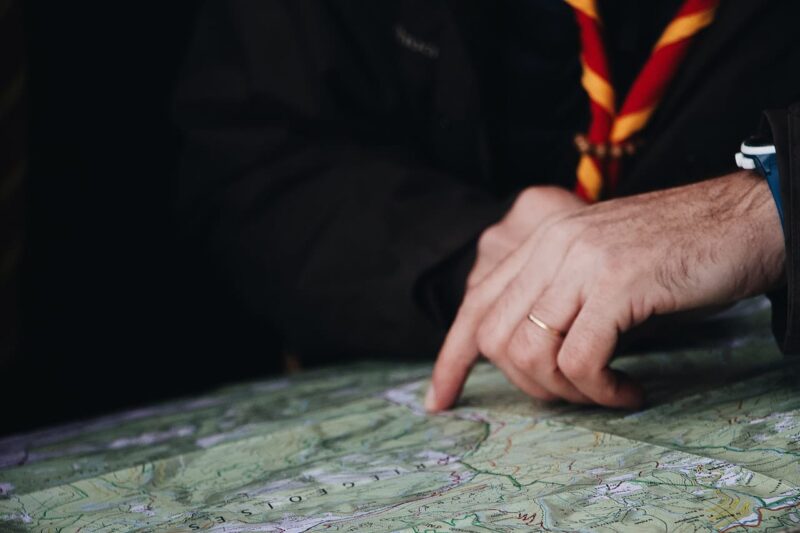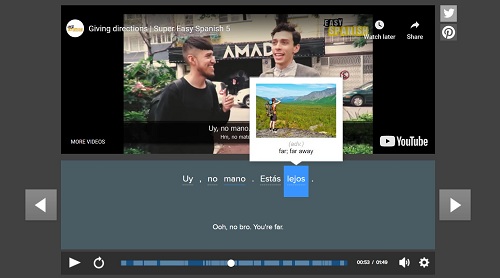
Are you planning on traveling to a Spanish-speaking country?
Then you should absolutely take the time to learn how to ask for and give directions in Spanish.
You’ll thank yourself the first time you get lost—and it’s a great way to practice Spanish with locals!
Even if you don’t have a trip on the horizon, asking for and giving directions in Spanish is a practical skill worth learning.
Read on for useful phrases, vocabulary and ways to practice.
Contents
Download:
This blog post is available as a convenient and portable PDF that you
can take anywhere.
Click here to get a copy. (Download)
19 Key Phrases for Giving and Receiving Directions in Spanish

If any of the vocabulary in this section is new to you, be sure to review each word individually and note when they may change forms. I’ve provided a handy set of reference tables in the next section if you want to jump ahead.
Approaching people for help
Before you ask for directions, you’ll want to say hello. Spanish has greetings for every situation, but here are the best ways to politely break the ice with a stranger.
Hola. – Hello.
Hola, Señor/Señora.
Hello, Sir/Ma’am.
Buenos días. – Good morning.
Substitute buenos días with buenos tardes (good afternoon) or buenos noches (good evening) depending on the time of day.
¡Hola, buenos días!
Hello, good morning!
Disculpe. – Excuse me (formal).
Disculpe, estoy perdido.
Excuse me, I’m lost.
¿Me puedes ayudar? – Can you help me?
¿Me puedes ayudar, por favor?
Can you help me, please?
Asking for directions
Estoy perdido/a. – I’m lost.
Disculpe, estoy perdida. ¿Me puedes ayudar?
Excuse me, I’m lost. Can you help me?
Necesito ayuda. – I need help.
Necesito ayuda encontrar mi hotel.
I need help finding my hotel.
Dónde está… – Where is…
¿Dónde está el parque de Retiro?
Where is Retiro Park?
Estoy buscando… – I’m looking for…
Estoy buscando la calle Flores.
I’m looking for Flower Street.
¿Hay un/una _____ por aquí? – Is there a(n) _____ around here?
Hay un buen restaurante por aquí?
Is there a good restaurant around here?
¿Está [cerca/lejos]? – Is it [close/far away]?
¿Está lejos la avenida 9 de Julio?
Is July 9th Avenue far away?
Giving directions
Sigue recto. – Continue straight.
Sigue recto hasta el semáforo.
Continue straight until the stoplight.
Sigue la calle _____. – Follow _____ Street.
You can replace calle (street) with other similar words like avenida (avenue), carretera (highway), callejón (alleyway) or puente (bridge). In Spanish, unlike in English, these words generally come before the street name, not after.
For example, if a street were called Chile Street in English, it’d be called calle Chile in Spanish.
Sigue la avenida de España.
Follow Spain Avenue.
[Gira/dobla] a la [derecha/izquierda]. – Turn [right/left].
Cuando llegues al parque, gira a la derecha.
When you arrive at the park, turn right.
[Ve/camina/conduce] hasta _____. – [Go/walk/drive] until the _____.
Camina hasta el gimnasio y gira a la izquierda.
Walk until the gym and turn left.
Toma la primera [derecha/izquierda]. – Take the first [right/left].
You can also substitute primera (first) with segunda (second) or tercera (third) based on your needs.
Sigue recto, y toma la segunda izquierda.
Continue straight, and take the second left.
Está a la [derecha/izquierda]. – It’s on the [right/left].
El banco está en la calle principal. Está a la derecha.
The bank is on Main Street. It’s on the right.
Está al lado de _____. – It’s next to _____.
[Está + a preposition + a place] is a formula that you can use to describe the location of something relative to another location.
Mi casa está en frente de la escuela.
My house is across from the school.
Está a _____ minutos. – It’s _____ minutes away.
No está lejos. Está a diez minutos caminando.
It’s not far. It’s ten minutes away on foot.
Está a _____ [cuadras/manzanas/millas/kilómetros]. – It’s _____ [blocks/miles/kilometers] away.
Tendrás que conducir al restaurante. Está a cinco kilómetros de aquí.
You’ll have to drive to the restaurant. It’s five kilometers from here.
49 Key Vocabulary Words for Directions in Spanish

This vocabulary list contains dozens of the most useful words related to Spanish directions. Click on each one to hear its pronunciation!
Nouns
Adjectives
Verbs
Prepositions
Adverbs
| Spanish | English |
|---|---|
| Recto | Derecho | Straight (to describe an action, like “walk straight”) |
How to Use the Command Form to Give Directions in Spanish

What good are Spanish direction verbs if you can’t conjugate them?
When you give directions in Spanish, you’ll most likely be using the mandato (command) verb form.
If you’re completely unfamiliar, click here for a rundown on Spanish commands. Fear not—they’re simple to conjugate and have very few irregularities!
As a quick refresher, there are four basic command forms:
- the tú form (informal singular)
- the usted form (formal singular)
- the vosotros form (informal plural)
- the ustedes form (formal plural)
Remember that vosotros is only used in Spain; in Latin America, ustedes is used to speak to any group of people, regardless of the formality of the situation. Read more about the differences between Castillian and Latin American Spanish here.
To give directions, you’ll probably only need affirmative commands (i.e. telling people what to do), so that’s what I’ll cover here.
Quick tip: All of the verbs on this article’s verb list are regular in the command form, except for ir (to go). Its tú form is ve, its usted form is vaya, its vosotros form is id and its ustedes form is vayan.
The tú form
Commands in the tú form are the same as the él/ella/usted form of the simple present.
The usted form
Commands in the usted form are the same as the él/ella/usted form of the present subjunctive.
The vosotros form
To form commands in the vosotros form, simply remove the r at the end of the infinitive and add a d.
The ustedes form
And to form commands in the ustedes form, use the ellos/ellas/ustedes form of the present subjunctive.
Why It’s Important to Learn Spanish Directions

If you’re going to a Spanish-speaking country, you’ll likely need to ask for directions at some point! (Especially if you happen to be bad with a map, like me.)
It’s obviously important to know how to ask for directions—but if you can’t understand the response, you’ll be just as lost.
Learning about directions allows you to practice lots of useful vocabulary. It also forces you to pay attention to tricky prepositions and verb conjugations (especially the command form).

If you want to see all this directional vocab in use, you can do so with FluentU. This language learning program provides authentic videos made by and for native Spanish speakers, as well as the tools to help you understand every word.

The interactive subtitles—vetted by Spanish language experts—can be toggled on and off. Hover over a word to see a contextual definition. Click on the word to get example sentences, links to other videos containing the word and more.
Practice Suggestions for Learning All Your Spanish Directions

Here are three easy, do-it-yourself exercises to learn Spanish directions or simply refresh your memory.
Writing practice: Choose two locations in your neighborhood or city, and write how to get from one to the other in Spanish.
Speaking/listening practice: Find a practice buddy and a map. Choose a starting point on the map together. Choose an endpoint, but don’t share it with your friend.
Now, tell your friend (in as much detail as possible) how to get from the start to the end. Switch places to practice both speaking and listening!
Comprehension practice: Switch your phone to Spanish when using your map app. With walking directions, you’ll practice your reading comprehension and during car trips you’ll work on your listening comprehension.
Hopefully these simple phrases and vocabulary words will help you feel less lost when asking for directions in Spanish.
So, where are you headed? Sit down with a map or get out on the street and start practicing!
Download:
This blog post is available as a convenient and portable PDF that you
can take anywhere.
Click here to get a copy. (Download)



